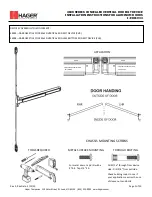
EN
Multiprocess 175. Operating manual.
Multiprocess 175. Operating manual.
31
30
11. Troubleshooting guide.
10. Technical specifications.
11.1 TIG/MMA functions
Problem
Excessive electrode
consumption
Erratic arc
Inclusion of tungsten
or oxides in weld
Cause
Inadequate gas flow
Inadequate post gas flow
Improper size electrode for current required
Operating of reverse polarity
Electrode contamination
Excessive heating inside torch
Electrode oxidising during cooling
Shield gas incorrect
Incorrect voltage (arc too long)
Current too low for electrode size
Electrode contaminated
Joint too narrow
Contaminated shield gas. Dark stains on the electrode or
weld bead indicate contamination
Base metal is oxidised, dirty or oily
Improper lift arc starting technique
Poor scratch starting technique
Excessive current for tungsten size used
Accidental contact of electrode with puddle
Accidental contact of electrode to filler rod
Using excessive electrode extension
Inadequate shielding or excessive drafts
Wrong gas
Heavy surface oxides not being removed
Solution
Increase gas flow
Increase post flow time to 1 sec per 10 amps
Use larger electrode
Use larger electrode or change polarity
Remove contaminated portion, then prepare again
Replace collet. Try wedge collet or reverse collet
Increase post flow time before turning off valve
Change to proper gas (no oxygen or CO₂)
Maintain short arc length
Use smaller electrode or increase current
Remove contaminated portion, then prepare again
Open joint groove
The most common cause is moisture or aspirated air in gas
stream. Use welding grade gas only. Find the source of the
contamination and eliminate it promptly
Use appropriate chemical cleaners, wire brush, or abrasives
prior to welding
Follow directions as set out on page 15
Many codes do not allow scratch starts. Use copper strike
plate. Use high frequency arc starter
Reduce the current or use larger electrode
Maintain proper arc length
Maintain a distance between electrode and filler metal
Reduce the electrode extension to recommended limits
Increase gas flow, shield arc from wind, or use gas lens
Do not use ArO₂ or ArCO₂ GMAW (MIG) gases for TIG welding
Use wire brush and clean the weld joint prior to welding
Specifications
Part no.
Power voltage
Frequency
Rated input current
Output current
MMA
TIG
MIG
Rated working voltage
No-load voltage
Duty cycle
Wire feeder
Wire feeder speed
Post flow time
Welding wire diameter
Remote control
Efficiency
Power factor
Insulation grade
Housing protection grade
Welding thickness
Dimensions L×W×H
Weight
Standards
Multiprocess 175
RYVAL 175 MULTI
Single phase 240V ±15%
50/60Hz
28A
20 to175A
10 to175A
50 to175A
16.5 to 22.8V
56V
35%
Internal
2 to12m/min
3 s
0.6/0.8/1.0mm
No
80%
0.73
F
IP23S
>0.8mm
420×220×439mm
12.8kg
IEC 60974-1






































